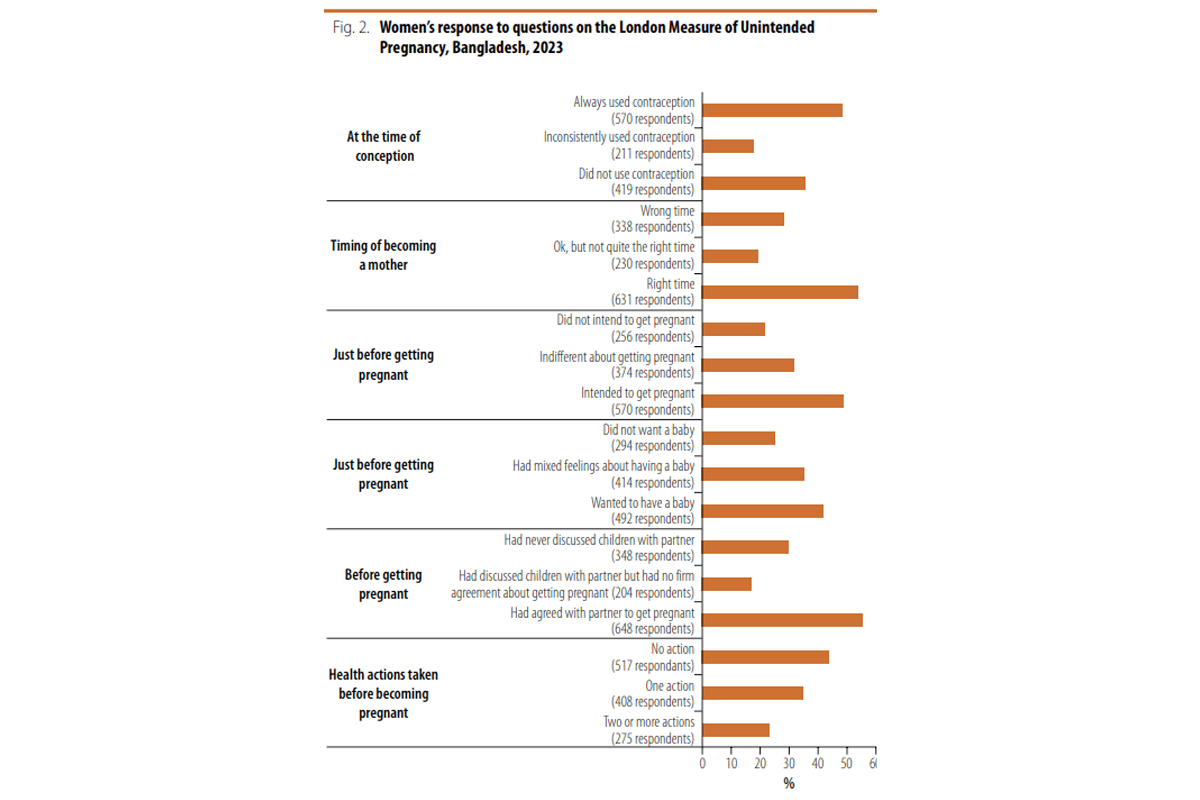
by Md Nuruzzaman Khan,a Shimlin Jahan Khanama, Melissa L Harris
Bulletin of the World Health Organization, 2024;102:562–570.
Globally, about half of pregnancies (roughly 121 million) are unintended, with low- and middle-income countries bearing the brunt due to lower use of modern contraception and higher unmet contraceptive needs. In Bangladesh, unintended pregnancy is an important issue. In one study, 25.2% (1131/4493) of women with live births reported that the pregnancy was unintended. Unintended pregnancies can have substantial adverse effects on maternal and child health, especially in low and middle-income countries such as Bangladesh, where safe abortion services are limited by law. Around two thirds of unintended pregnancies in low- and middle-income countries and Bangladesh result in induced abortions. These abortions account for an estimated 13.0% of total maternal deaths and incur substantial costs for treating abortion-related complications. Unintended pregnancies leading to live births can result in delayed or inaccessible maternal and childcare, increasing the risk of adverse outcomes such as stillbirths, preterm births, low birth weight, child undernutrition, and neonatal and maternal mortality. Intergenerational effects of unintended pregnancy, including higher rates of school dropout, have also been observed in studies conducted in low- and middle-income countries such as Bangladesh.
Increasing access to modern contraception and comprehensive sex education is vital to reduce unintended pregnancies in Bangladesh. The accuracy of current estimates of unintended pregnancy is a global concern, particularly in low- and middle-income countries where prospective data on reproductive events (e.g. conception and birth) are scarce, and data on unintended pregnancy usually come from nationally representative Demographic and Health Surveys (DHS). These surveys collect timing-based data on pregnancy intention using two questions. Their questions have several limitations, including recall bias, particularly in accurately remembering pregnancy intentions at conception, and a higher likelihood of ambivalent responses, especially when the child’s sex differs from the sex the parents desire or when pregnancy intentions change after childbirth. The main reasons for these limitations include: (i) exclusion of women who have had induced abortions; (ii) lack of inclusion of partners’ perspectives, despite their important role in pregnancy decisions; and (iii) failure to consider contraceptive use or non-use status at conception. These factors can lead to ambivalence, denial and confusion about pregnancy, and misreporting of partners’ intentions, as a considerable portion of reported unintended pregnancies in low- and middle-income countries are wanted by the husband.
To comprehensively measure pregnancy intention, multiple dimensions need to be considered, such as contraception use, feelings about pregnancy at conception and after birth, and partner agreement.12 The London Measure of Unplanned Pregnancy addresses these issues and can overcome the limitations of the DHS measure of pregnancy intention.13 However, the London Measure of Unplanned Pregnancy is not commonly used in low- and middle-income countries and it has not been integrated into national surveys.11–14 Furthermore, no previous investigation has been done into the discordance between the DHS measure of pregnancy intention and the London Measure of Unplanned Pregnancy or the factors contributing to this discordance. The aim of our study therefore was to estimate the prevalence of unintended pregnancy in Bangladesh using these two measures: the DHS timing-based estimate and the London Measure of Unplanned Pregnancy. We also sought to determine the degree of discordance between the prevalence estimates obtained from these two measures and identify the factors that contribute to this discordance.



